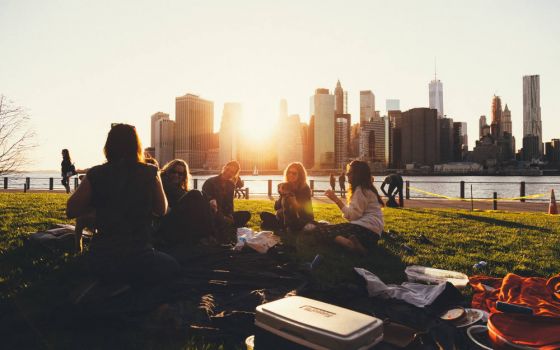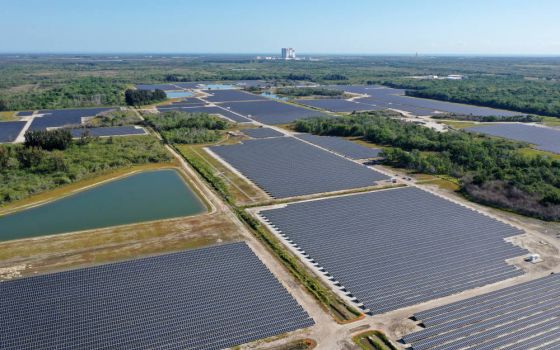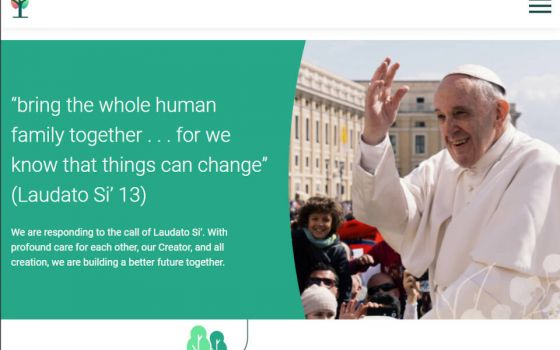A woman cools off at the Barcaccia fountain near Rome's Spanish Steps Aug. 12, during a heatwave across Italy. Authorities in Italy said the island of Sicily may have set an all-time heat record for Europe, hitting a temperature of 119.8 degrees Fahrenheit. (CNS photo/Guglielmo Mangiapane, Reuters)
Editor's Note: EarthBeat Weekly is your weekly newsletter about faith and climate change. Below is the Aug. 27 edition. To receive EarthBeat Weekly in your inbox, sign up here.
Since about a decade ago, more than half the world's population has lived in urban areas. These cityscapes, with their high-rise buildings, roads, factories and parking lots tend to have higher temperatures than rural areas, where there is more vegetation. As more densely built and populated zones started showing up as hot spots on satellite photos, they were dubbed "urban heat islands."
When scientists took a closer look, however, they found that cities are not uniformly hot. Rather, there are heat islands within the heat islands. They generally are places where there is more asphalt than greenery, and often where the neighborhoods are home to people who have lower incomes and fewer options.
This week, EarthBeat took a look at the heat island effect, how scientists are studying it, how it's impacting communities and what can be done to dial back the thermostat for urban dwellers.
NCR environment correspondent Brian Roewe reported on a project led by the U.S. National Oceanographic and Atmospheric Administration, in which citizen scientists have helped gather data to create heat maps of more than 40 cities and communities in the United States. The studies found that temperatures can vary by as much as 20 degrees Fahrenheit from one neighborhood to another.
In Houston, Texas, one of the cities that has been mapped, some neighborhoods do not cool off at night, writes Nushin Huq. That's a health hazard, because studies have shown that high nighttime temperatures can increase the risk of death.
We humans have created these heat islands — and it's within our power to cool them off, researchers say. Adding green space seems like the obvious way to dial down the temperature, but studies have found that there's no one-size-fits-all solution for urban heat islands.
In general, removing vegetation turns the heat up, while expanding the amount of vegetation and decreasing the amount of pavement helps lower temperatures. So does increasing the ability of pavement and roofs to reflect sunlight, which is known as the albedo effect.
But when scientists looked at neighborhoods in Portland, Oregon, that have different amounts of vegetation — some with mature trees, some with lower vegetation, others with a mix of trees and buildings, and some with virtually no greenery at all — they found that cooling methods were most effective when they were tailored to the characteristics of the local area.
In neighborhoods with mature trees, for example, the greatest effect would come not from planting more trees, but from preserving the ones that are already there. Neighborhoods with less vegetation or with a greater variety of buildings, trees and roads would benefit from both the addition of trees and an increase in albedo — painting roadways and roofs a light color.
Living in a neighborhood here in Peru's sprawling capital city, where single-family homes with gardens are rapidly giving way to apartment buildings with little greenery, I'd always thought that green roofs were invariably a plus for the climate.
The Portland study, however, shows mixed results. Depending on the situation, a white roof might have a greater cooling effect than a green one. But the researchers note that climate isn't the only consideration, because plants on urban roofs have other environmental benefits, such as helping to reduce air pollution and providing habitat for birds.
The key, apparently, is to know your neighborhood and advocate for policies that will have the greatest impact in your situation, so that all of those local effects combined spread across a wider area and help cool down the city as a whole.
But it's not always easy to know your local ecosystem and maintain a sense of connection with it when you live in a labyrinth of highways and high-rises. So next month, during the Season of Creation, faith-based groups will give us a chance to reset that relationship.
Advertisement
This year's Season of Creation, which begins Sept. 1 and continues through Oct. 4, the feast of St. Francis of Assisi, invites us to "renew the oikos of God" — using the Greek word for "home" or "household," from which we get the prefix "eco," as in "ecology."
If you're not familiar with the Season of Creation, or if you're raising awareness about it with your parish or faith group, you can find a thorough review in Roewe's response to the Burning Question "What is the Season of Creation?"
Parishes looking for resources may find a Catholic liturgical guide created by Jesuit Fr. James Hug useful for planning Sunday liturgies during the Season of Creation. The guide, available here in English and Spanish, offers suggestions for the penitential rite, prayers during the liturgy, Scripture reflections and more. You can find other ideas on the Season of Creation website.
Beginning Wednesday, Sept. 1, EarthBeat will offer reflections by Brenna Davis and Michael Downs of the Ignatian Solidarity Network. Drawing on Pope Francis' encyclical "Laudato Si', on Care for Our Common Home," the reflections invite us to develop a deeper sense of being grounded in the place where we live.
"Each week of the series will be based around a different element (earth, water, air and fire), and each day of the week the reflections will follow a thematic rotation," Davis told me. "Mondays will focus on centering ourselves in gratitude. Wednesdays will explore grief though guest writers who share their personal experiences of how their homes are being impacted by climate change or poor stewardship. And Fridays will center around going forth and our response to these realities."
She added, "We hope that this series will provide a space for people to drop into their hearts, to notice how they are feeling in the midst of this environmental moment, to reconnect with their homes, and as they are renewed by the earth, to consider how they are being called to act and to renew creation in return."
You can sign up here to receive the reflections in your inbox every Monday, Wednesday and Friday during the Season of Creation. Each day includes suggestions for prayerful reflection and action for individuals, families or faith groups.
With the United Nations climate summit, known as COP26, just a little over two months away, the Season of Creation provides a good opportunity to give serious and prayerful consideration to the various forms of action and advocacy in which we can engage to help restore our common home.
Here's what else is new on EarthBeat:
- Although she didn't call it "sustainable living," Matt Naveau's grandmother taught him how to live out Laudato Si' by her example. Throwing away good food or toys or clothes, as our throwaway culture today encourages us to do, was never a consideration, he writes.
- Parishioners and community members responded with "phenomenal" support after record-breaking rainfall triggered flash floods in Tennessee that left 20 people dead and hundreds of homes damaged or destroyed, reports Katie Peterson for Catholic News Service.
- And at Global Sisters Report, Mercy Sr. Jennifer Wilson reflects on what salmon can teach us in this pandemic year.
Here's more news from the climate beat:
- Bob Berwyn at Inside Climate News reports on new research that shows how global warming is leading to more intensive rainfall and flooding like that seen in parts of Europe, China and the U.S. recently.
- At CalMatters, Jane Braxton Little explains how policies that led to decades of fire suppression in public forests created conditions that fuel wildfires now, especially when combined with our warming climate.
- Under pressure from Republican legislators and fossil fuel companies, the Biden administration announced plans to auction oil and gas leases later this year, while it continues to fight in court for the right to suspend drilling on public lands, reports Heather Richards at E&E News.
- Meanwhile, Celina Tebor at the Los Angeles Times reports that the administration is aiming to double U.S. wind energy use by 2030 to 30 gigawatts, enough to provide power to about 10 million homes.
- In February 2020, a leak from a pipeline carrying carbon dioxide used for fracking sickened dozens of people in Mississippi, raising safety questions about infrastructure for proposed carbon-capture schemes, writes Dan Zegart at HuffPost.
Upcoming events:
On Aug. 31, the Catholic Climate Covenant will offer a virtual training session to help Catholics learn techniques for encouraging bishops, parish priests and other church leaders to become involved in issues related to climate change and care for creation.
You can find more information about this and other upcoming events on the EarthBeat Events page.
Closing beat:
What is your parish, diocese or faith group planning for the Season of Creation? You can add your events to the EarthBeat Events page, and if you find useful resources, please let us know about them by writing us at earthbeat@ncronline.com, so we can share them.
If you enjoy EarthBeat, please spread the word — you can pass along the link to EarthBeat Weekly or suggest to friends that they sign up here to receive this newsletter every Friday in their inbox. Thank you for reading EarthBeat!







